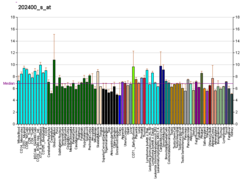血清応答因子
表示
血清応答因子(けっせいおうとういんし、英: serum response factor、略称: SRF)は、転写因子として機能するタンパク質である[5]。
機能
[編集]血清応答因子はMADSボックススーパーファミリーに属する転写因子である[6]。このタンパク質は、標的遺伝子のプロモーター内の血清応答エレメント(serum response element; SRE)に結合する。このタンパク質はc-fosを含む多くの最初期遺伝子の活性を調節しており、それによって細胞周期の調節、アポトーシス、細胞成長、細胞分化に関与している。SRFは多くのシグナル伝達経路の下流の標的となっており、一例としてMAPK経路はTCFファミリー(ternary complex factor)を介してSRFの転写活性を調節する[7][8]。
SRFは胚発生時に重要であり、中胚葉の形成と関連づけられている[9][10]。完全に発達した哺乳類では、SRFは骨格筋の成長に重要である[11]。SRFとステロイドホルモン受容体などとの相互作用は、ステロイドによる筋成長の調節に寄与している可能性がある[12]。またELK1などのTCFとミオカルディンはSRFをめぐって競合し、それぞれ平滑筋遺伝子の発現を抑制、促進する[13]。
臨床的意義
[編集]SRFの欠損は乾癬やその他の皮膚疾患と関連している[14]。
相互作用
[編集]SRFは次に挙げる因子と相互作用することが示されている。
出典
[編集]- ^ a b c GRCh38: Ensembl release 89: ENSG00000112658 - Ensembl, May 2017
- ^ a b c GRCm38: Ensembl release 89: ENSMUSG00000015605 - Ensembl, May 2017
- ^ Human PubMed Reference:
- ^ Mouse PubMed Reference:
- ^ “Isolation and properties of cDNA clones encoding SRF, a transcription factor that binds to the c-fos serum response element”. Cell 55 (6): 989–1003. (December 1988). doi:10.1016/0092-8674(88)90244-9. PMID 3203386.
- ^ “The MADS-box family of transcription factors”. Eur. J. Biochem. 229 (1): 1–13. (April 1995). doi:10.1111/j.1432-1033.1995.0001l.x. PMID 7744019.
- ^ “Isolation and characterization of SRF accessory proteins”. Philos. Trans. R. Soc. Lond. B Biol. Sci. 340 (1293): 325–32. (June 1993). Bibcode: 1993RSPTB.340..325D. doi:10.1098/rstb.1993.0074. PMID 8103935.
- ^ “SRF serum response factor [Homo sapiens (human) - Gene - NCBI]”. www.ncbi.nlm.nih.gov. 2024年10月5日閲覧。
- ^ “Combinatorial expression of GATA4, Nkx2-5, and serum response factor directs early cardiac gene activity”. J. Biol. Chem. 277 (28): 25775–82. (July 2002). doi:10.1074/jbc.M203122200. PMID 11983708.
- ^ “Serum response factor, an enriched cardiac mesoderm obligatory factor, is a downstream gene target for Tbx genes”. J. Biol. Chem. 280 (12): 11816–28. (March 2005). doi:10.1074/jbc.M412408200. PMID 15591049.
- ^ “Requirement for serum response factor for skeletal muscle growth and maturation revealed by tissue-specific gene deletion in mice”. Proc. Natl. Acad. Sci. U.S.A. 102 (4): 1082–7. (January 2005). Bibcode: 2005PNAS..102.1082L. doi:10.1073/pnas.0409103102. PMC 545866. PMID 15647354.
- ^ “Recruitment of the androgen receptor via serum response factor facilitates expression of a myogenic gene”. J. Biol. Chem. 280 (9): 7786–92. (March 2005). doi:10.1074/jbc.M413992200. PMID 15623502.
- ^ Wang, Zhigao; Wang, Da-Zhi; Hockemeyer, Dirk; McAnally, John; Nordheim, Alfred; Olson, Eric N. (2004-03-11). “Myocardin and ternary complex factors compete for SRF to control smooth muscle gene expression”. Nature 428 (6979): 185–189. doi:10.1038/nature02382. ISSN 1476-4687. PMID 15014501.
- ^ “Loss of serum response factor in keratinocytes results in hyperproliferative skin disease in mice”. J. Clin. Invest. 119 (4): 899–910. (April 2009). doi:10.1172/JCI37771. PMC 2662566. PMID 19307725.
- ^ “Novel transcription coactivator complex containing activating signal cointegrator 1”. Mol. Cell. Biol. 22 (14): 5203–11. (July 2002). doi:10.1128/mcb.22.14.5203-5211.2002. PMC 139772. PMID 12077347.
- ^ a b “Interaction of ATF6 and serum response factor”. Mol. Cell. Biol. 17 (9): 4957–66. (September 1997). doi:10.1128/MCB.17.9.4957. PMC 232347. PMID 9271374.
- ^ “Ras regulates the association of serum response factor and CCAAT/enhancer-binding protein beta”. J. Biol. Chem. 274 (20): 14224–8. (May 1999). doi:10.1074/jbc.274.20.14224. PMID 10318842.
- ^ “Regulation of the cfos serum response element by C/EBPbeta”. Mol. Cell. Biol. 17 (3): 1744–55. (March 1997). doi:10.1128/mcb.17.3.1744. PMC 231899. PMID 9032301.
- ^ a b “PML-nuclear bodies are involved in cellular serum response”. Genes Cells 8 (3): 275–86. (March 2003). doi:10.1046/j.1365-2443.2003.00632.x. PMID 12622724.
- ^ “The B-box dominates SAP-1-SRF interactions in the structure of the ternary complex”. EMBO J. 20 (12): 3018–28. (June 2001). doi:10.1093/emboj/20.12.3018. PMC 150215. PMID 11406578.
- ^ “Cardiac tissue enriched factors serum response factor and GATA-4 are mutual coregulators”. Mol. Cell. Biol. 20 (20): 7550–8. (October 2000). doi:10.1128/mcb.20.20.7550-7558.2000. PMC 86307. PMID 11003651.
- ^ “Serum response factor-GATA ternary complex required for nuclear signaling by a G-protein-coupled receptor”. Mol. Cell. Biol. 21 (4): 1036–44. (February 2001). doi:10.1128/MCB.21.4.1036-1044.2001. PMC 99558. PMID 11158291.
- ^ “Interaction with RAP74 subunit of TFIIF is required for transcriptional activation by serum response factor”. Nature 373 (6515): 632–5. (February 1995). Bibcode: 1995Natur.373..632J. doi:10.1038/373632a0. PMID 7854423.
- ^ “Role of transcription factor TFIIF in serum response factor-activated transcription”. J. Biol. Chem. 269 (5): 3489–97. (February 1994). doi:10.1016/S0021-9258(17)41889-8. PMID 8106390.
- ^ “A multifunctional DNA-binding protein that promotes the formation of serum response factor/homeodomain complexes: identity to TFII-I”. Genes Dev. 11 (19): 2482–93. (October 1997). doi:10.1101/gad.11.19.2482. PMC 316568. PMID 9334314.
- ^ “TFII-I enhances activation of the c-fos promoter through interactions with upstream elements”. Mol. Cell. Biol. 18 (6): 3310–20. (June 1998). doi:10.1128/mcb.18.6.3310. PMC 108912. PMID 9584171.
- ^ “Physical interaction between the mitogen-responsive serum response factor and myogenic basic-helix-loop-helix proteins”. J. Biol. Chem. 271 (9): 5258–64. (March 1996). doi:10.1074/jbc.271.9.5258. PMID 8617811.
- ^ “Myogenic basic helix-loop-helix proteins and Sp1 interact as components of a multiprotein transcriptional complex required for activity of the human cardiac alpha-actin promoter”. Mol. Cell. Biol. 19 (4): 2577–84. (April 1999). doi:10.1128/MCB.19.4.2577. PMC 84050. PMID 10082523.
- ^ “Identification of proteins that interact with NF-YA”. FEBS Lett. 460 (1): 41–5. (October 1999). Bibcode: 1999FEBSL.460...41Y. doi:10.1016/s0014-5793(99)01311-3. PMID 10571058.
- ^ “Silencing mediator of retinoic acid and thyroid hormone receptors, as a novel transcriptional corepressor molecule of activating protein-1, nuclear factor-kappaB, and serum response factor”. J. Biol. Chem. 275 (17): 12470–4. (April 2000). doi:10.1074/jbc.275.17.12470. PMID 10777532.
- ^ “Steroid receptor coactivator-1 interacts with serum response factor and coactivates serum response element-mediated transactivations”. J. Biol. Chem. 273 (44): 28564–7. (October 1998). doi:10.1074/jbc.273.44.28564. PMID 9786846.
- ^ “Physical interaction between the MADS box of serum response factor and the TEA/ATTS DNA-binding domain of transcription enhancer factor-1”. J. Biol. Chem. 276 (13): 10413–22. (March 2001). doi:10.1074/jbc.M008625200. PMID 11136726.
関連文献
[編集]- “Rho-actin signaling to the MRTF coactivators dominates the immediate transcriptional response to serum in fibroblasts”. Genes & Development 28 (9): 943–58. (May 2014). doi:10.1101/gad.239327.114. PMC 4018493. PMID 24732378.
- “Suppression of the ERK–SRF axis facilitates somatic cell reprogramming”. Experimental & Molecular Medicine 50 (2): e448. (Feb 2018). doi:10.1038/emm.2017.279. PMC 5903827. PMID 29472703.
- “Serum Response Factor (SRF) Drives the Transcriptional Upregulation of the MDM4 Oncogene in HCC”. Cancers 13 (2): 199. (January 2021). doi:10.3390/cancers13020199. PMC 7829828. PMID 33429878.
- “Reprogramming progressive cells display low CAG promoter activity”. Stem Cells 39 (1): 43–54. (January 2021). doi:10.1002/stem.3295. PMC 7821215. PMID 33075202.
- “Cyclase-associated protein 2 (CAP2) controls MRTF-A localization and SRF activity in mouse embryonic fibroblasts”. Scientific Reports 11 (1): 4789. (February 2021). Bibcode: 2021NatSR..11.4789K. doi:10.1038/s41598-021-84213-w. PMC 7910472. PMID 33637797.







